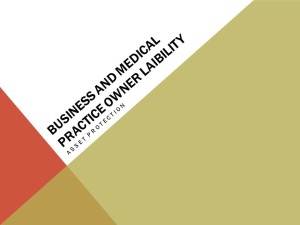 Here are some key conceptual issues about Asset Protection doctors and business owners should understand as we go into a new year:
Here are some key conceptual issues about Asset Protection doctors and business owners should understand as we go into a new year:
1. The best medicine, just as in your profession, is prevention, not treatment. Timing is always a key concept from a legal perspective; you may be legally unable to act (fraudulent conveyance, voidable transaction, etc.) or put in a position where the results are much less predictable and often more expensive if you try to implement even the best asset protection strategies against a known and existing exposure.
2. Asset protection is not just one thing; it’s a system and lifestyle, just like wellness. I warn the doctors I work with all over the country that there is no “magic pill” in asset protection and that when done right it involves four key areas:
• Clean living. A good first step is avoiding or eliminating legally risky behavior and not getting in trouble in the first place. This means having good, professionally drafted, legally compliant policies and procedures in place, and actually following and enforcing them uniformly.
• Managing risk factors. This means using experienced help in properly identifying all (or as many as possible) of your risks and addressing them proactively. A common mistake by doctors is failing to think beyond just medical malpractice risk. While that risk is very real and can be financially fatal, there are many others I’ve covered ranging from employee-related liabilities, to debt, Medicare audits, and even director’s and officer’s legal liability for practice owners and executives; this is just a small sample of the other issues that can negatively affect physicians who often overlook their personal liability in variety of areas as well. For instance, losing sleep over the possibility of a med-mal claim, but not having adequate personal liability insurance to cover an exposure at home, with family cars or for the actions of children.
• Insurance — and lots of it. Clients often ask me how much insurance they should have in place, and I say the same thing every time, “Every dollar you can afford, then have a back-up plan.” This goes far beyond your professional liability or malpractice insurance and includes half a dozen or more varieties of specialty insurance that I’ve discussed before, and that can be well covered with the help of a top-notch property and casualty (P&C) insurance agent.
• Defensive legal structures. There will be gaps in the number of things that can be covered or the dollar limit to which you can insure yourself. This is where all the trusts, partnerships, corporate structures, estate-planning techniques, etc., that lawyers are so fond of talking about come into play. As an attorney who uses these structures every day I’ll be the first to remind you that this is only one piece of the puzzle required. If your lawyer can’t talk about anything but his own tools and can’t speak knowledgably about your real exposures as outlined above, get better help.
3. Finally, asset protection is fact specific. Every doctor seeking asset protection must have a thorough “exam” of her own assets, then have personal and professional risks “diagnosed,” and have tools and solutions “prescribed” by a qualified and experienced professional. Just as in medicine, there may very well be a proven course of treatment for a particular problem, but your lawyer should know what the problems are before they (or worse, a non-lawyer or you yourself) start proposing solutions.
This article originally appeared at www.PhysiciansPractice.com, the nation’s leading medical practice management resource, where Ike Devji is a regular contributor with over 150 bylines.


